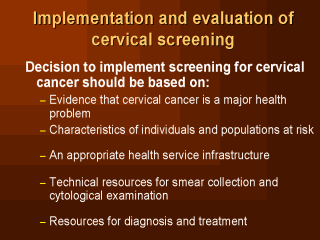| front |1 |2 |3 |4 |5 |6 |7 |8 |9 |10 |11 |12 |13 |14 |15 |16 |17 |18 |19 |20 |21 |review |
 |
If the national cancer incidence and
mortality rates are unavailable for your country, use data from hospitals and pathology
labs to see relative frequency of cancer types. Analysis of any cancer incidence and
mortality data should be made on the basis of age as well as sex, whenever possible. Age is the most important risk factor for the priority group. Also an inverse relationship between socioeconomic status and risk of cervical cancer has been observed in all countries. Furthermore, alongwith an appropriate health service infrastructure, technical resources for taking cervical smears as well as access to a cytology lab are essential. The initial introduction of screening services will result in identification of advanced cases. However, with the advent of time, sophisticated facilities will not be required for diagnosis and treatment of early cervical cancer and precancerous lesions, thus saving lives as well as money in the long run. |